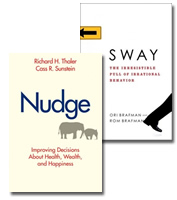Book Reviews: Nudge and Sway

Brafman, Ori and Rom Brafman. Sway: the irresistible pull of irrational behavior. Doubleday, 2008.
Thaler, Richard H. and Cass R. Sunstein. Nudge: improving decisions about health, wealth and happiness. Yale, 2008.
Most people consider themselves to be rational. They evaluate their options and make decisions rationally, or at least they think so. Recently, a number of books have been published that show that people routinely make bad decisions because they are not paying attention; because they are influenced by their emotions and expectations; because they are pressured by social norms; or because they have limited self control.
The most popular and well-regarded of these books is the best-selling Predictably Irrational by Fuqua faculty member Dan Ariely. Predictably Irrational is a fantastic book that has been reviewed extensively, including reviews in the New York Times and on NPR.
Predictably Irrational is the first go-to source in learning why and how people behave as they do. But two other new books also merit mention:
Brothers Ori and Rom Brafman have written an entertaining and informative look into the hidden influences that sometimes derails even the most principled decision-maker. Sway: the irresistible pull of irrational behavior introduces psychological concepts like loss aversion, diagnosis bias and the chameleon effect, mixing them with abundant examples from real life.
Sway is a slim book and a quick read, written in a conversational tone and easy humor. Even the endorsements page on the Amazon.com contains this disclaimer:
DISCLAIMER: If you decide to buy this book because of these endorsements, you just got swayed. One of the psychological forces you’ll read about in Sway is our tendency to place a higher value on opinions from people in positions of prominence, power, or authority.
In Nudge: improving decisions about health, wealth, and happiness, Richard Thaler and Cass Sunstein, both from the University of Chicago, describe the biases that lead decision makers to make mistakes that ultimately make people poorer or less healthy.
When making a choice, people are influenced by small changes in context or the environment. Given the right context, individuals can be nudged in the direction of a healthy or more productive choice. Sometimes it is as simple as informing people of what other people are doing, as in tax compliance. Or it can be effective to let people know what they themselves are doing, as in energy use.
An example of a nudge is daylight savings time. To get the nation to wake up an hour earlier, all the clocks are set forward one hour each spring. Everyone who normally wakes up at 7:00 am begins waking up at 6:00 am.
Thaler and Sunstein want to nudge people in the direction of making better choices for society. This would include decisions that improve health, personal savings, the environment, or even organ donations. They show how “choice architects” can design contexts that make it easier for people to make the best choices for themselves, without restricting the number of options available.
© Reviewer: Meg Trauner & Ford Library – Fuqua School of Business. All rights reserved.
Tags: Consumer behavior, Decision-making